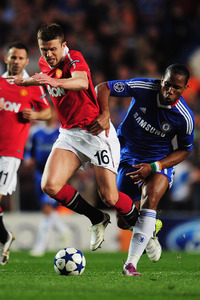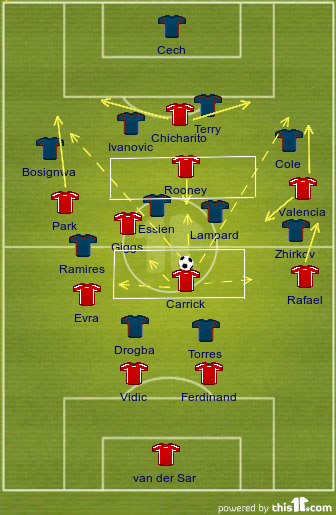
Traveling to Stamford Bridge on an European night and to come away victorious is a daunting task; one that requires a valiant and class performance by numerous squad members. This is precisely what happened when Manchester United emerged with a 0-1 victory over Chelsea FC in a UEFA Champions League quarter-final tie. Perhaps it is because not many other footballers can conjure up such a wide range of opinion on their value, or perhaps it is because his inconsistent form in recent times has lent credence to both sides of the debate, but no other player captured my attention on Wednesday evening like Michael Carrick did. He was simply superb. He was a midfield maestro. A romantic might say he was United's heartbeat.
I've generally been on the side of the argument that appreciates Carrick and I feel that his subtle contributions can easily go unnoticed. However, I've also become increasingly frustrated with the midfielder for his inconsistent performances since his shocker versus FC Barcelona in the 2009 Champions League final. There are many who are staunch defenders of Carrick, including Michael Cox, the editor of the fantastic website Zonal Marking. No matter which side of the divide one stands on when it comes to an opinion on Carrick, I think anyone who watched United's clash with Chelsea can agree that the midfielder played a vital role in the away side's success. On the evening's defining moment, it was Carrick who launched an incisive 50-yard diagonal ball that found Ryan Giggs into space before the Welshman teed up Rooney for what proved to be the winner. It was Carrick's vision and range of passing on this decisive sequence that provided the heartbeat for Giggs' sublime first-touch and Rooney's clinical finish.
A tactical breakdown on how and why Carrick was so key to United's victory after the jump...
As often can be the case for a player, tactics proved to be important reason why Carrick played so well. Chelsea played in an asymmetrical '4-4-2' for the first 71 minutes of the match. The shape was staggered horizontally, but not vertically. Thus, there was quite a bit of space in between the attacking, midfield, and defensive lines. While Rooney exposed the space between Chelsea's defense and midfield, it was Carrick, who in his role as a deep-lying playmaker, that exposed the space between Chelsea's midfield and strikers. Neither of the strikers, Didier Drogba or Fernando Torres, dropped back consistently to help in defending when United were in possession. In addition, with a two-man central midfield, Chelsea's Frank Lampard and Michael Essien were cautious in their movements as they didn't want to leave too much space in between themselves. Thus, Essien wasn't deep enough to track Rooney's deep movements and Lampard wasn't high enough up the pitch to occupy the deep-lying Carrick. He was able to simply swing the ball wide or hit the dangerous long diagonal down the flanks for the wide players or Javier 'Chicharito' Hernandez to run onto.

A common theme for Carrick when he struggles, and also virtually for any other midfielder, is when teams apply relentless pressure high up the pitch. No side in the world is better at this than Barcelona, thus, this helps partially explain why Carrick struggled so much in that final in Rome. He wasn't afforded adequate time or space to offer, receive, and turn so that he could look to distribute. Some are obviously better than others at negating this (i.e. Paul Scholes, Xavi Hernandez), but Carrick himself often struggles to distribute effectively when he receives the ball with his back to goal. This actually is the case for Xabi Alonso at times as well.
However, if Carrick is allowed time and space to receive and turn so that he can face the attack, then the playmaker is world-class in keeping possession and igniting the attack. In Wednesday night's Champions League match, Lampard didn't close down Carrick when the United midfielder received the ball, therefore, the midfielder was able to boss the center of the pitch. This chalkboard of Carrick's distribution versus Chelsea is courtesy of Total Football's iPhone app:

As you can see, Lampard not closing down on Carrick allowed him time to be both accurate and incisive with a wide range of passing. 36 passes completed out of 41 passes attempted (88%) is excellent. Carrick did well to both link with Giggs and Rooney in the middle and also to quickly swing the ball wide so that United could attack with width. Lampard was consistently 5-15 yards away from Carrick; much too far away to prevent Carrick from dictating play.
A common argument made is that Carrick too often passes the ball sideways or even backwards. This occurs at a higher rate when opposing midfielders press United. However, I argue that as long as Carrick is still completing a high percentage of passes, then this patient passing is highly beneficial to your team. Even by making the simple pass, your team keeps possession and allows time for the rest of your attack to build and get forward. Where I think the criticism is somewhat valid though is that Carrick still needs to hit the incisive direct pass on occasion to expose a relentless press.
Carrick was also very good in shielding his defense versus Chelsea. By playing in a deep-lying role, he is responsible for his share of defending. Carrick certainly isn't a destroyer in the mold of Nigel De Jong or the way Claude Makelele was, but he is sound defensively because of the way he reads the game and positions himself. At the Bridge, Carrick intercepted seven passes according to Opta, three more than any other player on the pitch. The other effective way that Carrick "defends" is by being so good at keeping possession. Attacking often is the best way to defend.
All in all, this was a brilliant performance by our creative central-midfielder. On a night where much went right for United and where there was spurts of attacking flow, it was Carrick that provided the heartbeat for it all.
http://www.thebusbybabe.com/2011/4/7/2095980/the-brilliance-of-michael-carrick-at-stamford-bridge
![[g]lobe Trekker](https://blogger.googleusercontent.com/img/b/R29vZ2xl/AVvXsEgrXwh0q56eFStY892cpKtlH_vE0qeIsdvrOqVvkK9ZrrMllo5JfUTVvUm-RPXgEOByCRO4ZDJn8T_4nBkGiVrLBh2IjJSjFNX4oxcoIOvCV55HYWpVIxfoALFLGxDfkNAOFWBmfMeyTRc/s1600-r/globe.png)

No comments:
Post a Comment